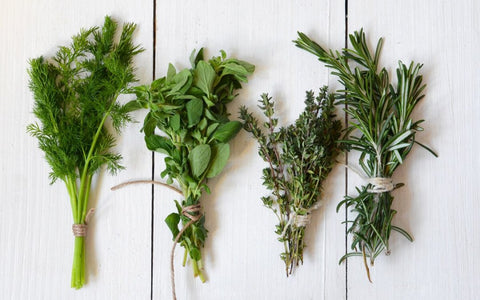Fresh herbs can be a delicious addition to almost any dish, but they’re not always readily available. Depending on where you live and your climate, you might not always have access to the fresh herbs you’re craving. Additionally, if you grow your own herbs, there might be times when you have more than you can use before they go bad. A great way to preserve your herbs for those leaner times of year is to dry them, and that’s exactly what we’ll be covering below.
How to Dry Herbs at Home
There are several methods you can use to dry your own herbs. The first is the hanging/air drying method.
Air Drying Method

Air drying is great because it doesn’t deplete the oils in the herbs, which is where all the flavor comes from. While you can use this method for almost any herb, we recommend it for varieties with lower moisture content, such as dill, rosemary, thyme, marjoram, and oregano.
The process is simple, but you’ll need to plan ahead and allow enough time. First, thoroughly wash the herbs and lay them out or pat them dry. Once dry, tie them together in a bundle and hang them upside down near a window for 5-7 days in sunlight. The herbs should be crisp and crumble easily when done.
Microwave Method
If you’re looking for a quick way to dry herbs, this method is for you! It’s better suited for herbs with lower oil content like parsley, mint, and oregano. (Check out the seeds we sell here). Start small to figure out the right timing, as it will vary from microwave to microwave. Spread your herbs on a plate between two towels (to absorb moisture) and microwave on high for 20 seconds. Check to see where they are; the towels should be moist, and the herbs dry and crumbly. Repeat as needed, but be careful—more delicate herbs can catch fire if left in the microwave for too long!
The Freezer Method

If you don’t have a microwave and don’t want to wait for air drying, the freezer method is a great alternative. This method works well for herbs with higher moisture content, like basil, tarragon, mint, rosemary, chives, and thyme. You can freeze herbs by laying them flat on a freezer tray and then storing them in an airtight container, or by chopping them and freezing them in an ice cube tray filled with oil (extra virgin olive oil works best). This method is convenient because the herbs are pre-portioned when you need them.
How Long Will Dried Herbs Last?

Once the drying and storage process is complete, it’s time to use your herbs! When cooking, use about 1 teaspoon of crumbled dried leaves in place of a tablespoon of fresh herbs. Dried herbs should be used within a year. A good gauge of their freshness is their color; as they start to lose color, they will also lose flavor.
How to Decide Which Dried Herbs to Use in Your Recipes

This is the fun part! There are endless uses for dried herbs. Try some dried parsley in our Apple Parsley Grilled Cheese Sandwich recipe, or use dill to add a Scandinavian touch to fish, egg dishes, and potatoes. Dried oregano is a staple and is generally considered better dried than fresh—try it in Italian and Mexican dishes, especially with tomatoes and cheese! Dried thyme is great in chicken dishes, dressings, and casseroles. Tear or shred dried lime leaves into Thai soups and curries for a distinctive citrus flavor. Finally, use dried rosemary in slow-cooked dishes like Italian-style soups, stews, braises, and lamb dishes.
Now that you know how to dry your own herbs, why not try growing them yourself? Check out our herb gardening kits so you always have fresh herbs at your fingertips!








There are no comments for this article. Be the first one to leave a message!